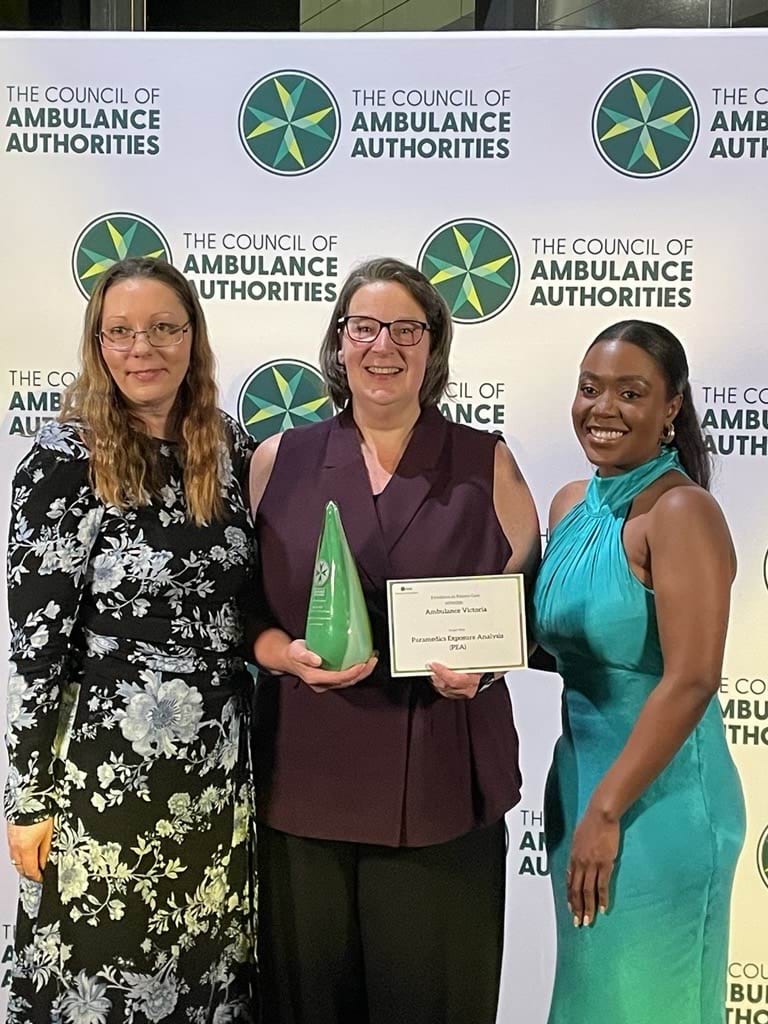Two innovative Ambulance Victoria (AV) projects have been recognised on the Australasian stage, with AV winning two categories at the Council of Ambulance Authorities (CAA) Awards for Excellence in Adelaide.
AV won the Excellence in Clinical Practice Award for the Safe Treatment of Atrial fibrillation in the communitY (STAY) project and also took home the Excellence in Patient Care Award for the Paramedics Exposure Analysis (PEA) project.
Winners of the coveted CAA awards are selected by an independent panel of industry experts, showcasing the dedication and ingenuity of ambulance professionals in the region.
The STAY project was delivered by AV's Quality and Clinical Innovation division and was an Australian-first prospective feasibility trial that began in November 2021, in partnership with Austin Health and Monash University.
The purpose of the STAY trial was to improve patient care by reducing unnecessary transports to emergency departments (ED), avoiding long wait times for both paramedics and patients, and ultimately directing patients to receive the most appropriate care.
The trial saw paramedics in metropolitan Melbourne administer metoprolol (beta-blocker) and rivaroxaban (anticoagulant) to haemodynamically stable patients with atrial fibrillation (AF) under the consultation of a cardiologist. All patients were then referred to an outpatient cardiology clinic led by the Austin Hospital within 24 hours of attendance.
AF is the most common cardiac arrhythmia but presents a significant challenge for health services despite advancements in prevention and management.
The findings of the trial indicated that the treatment and referral of low-risk AF patients by paramedics using an integrated model of care was both feasible and safe. The findings will be used to develop a statewide integrated model of care for AF patients involving virtual ED assessment and referral to outpatient cardiology clinics across Victoria.

The PEA project was delivered by AV's Analytics Development Team, with the primary aim of enhancing the proficiency and effectiveness of paramedics by providing an intuitive, rapid and reproducible analysis of their exposure to high-acuity cases.
PEA evaluates 28 specific case types, identified by their association with guidelines that mandate particular medications or procedures. By analysing these cases, PEA helps identify areas where paramedics need further training and upskilling, ensuring they are well-prepared for high-stakes situations.
Incorporating advanced data science techniques, PEA calculates the historical exposure of paramedics to high-acuity cases and predicts the likelihood of future high-acuity events. It identifies potential risks, particularly where there is a high probability of occurrence but low past exposure.
This dual capability allows for targeted interventions, such as specialised training programmes, to address critical skill gaps.
As a mandatory tool for clinical planning at AV, PEA has become an essential component in improving patient outcomes and enhancing the overall quality of emergency medical services. Its ability to pinpoint training needs and predict future risks makes it a valuable asset in the continuous development of paramedic proficiency.
AV was also a finalist in the Excellence in Staff Development, Excellence in Leadership, and Excellence in Mental Health and Wellbeing categories.
This year, the CAA Awards for Excellence received 46 submissions from ambulance services in Australia, New Zealand and Papua New Guinea.






